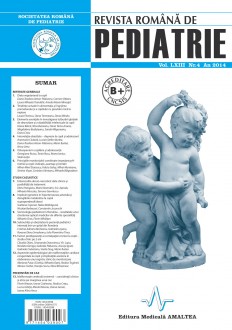SELECT ISSUE

Indexed

| |

|
|
|
| |
|
|
|

|
|
|
|
|
|
|
HIGHLIGHTS
National Awards “Science and Research”
NEW! RJP has announced the annually National Award for "Science and Research" for the best scientific articles published throughout the year in the official journal.
Read the Recommendations for the Conduct, Reporting, Editing, and Publication of Scholarly work in Medical Journals.
The published medical research literature is a global public good. Medical journal editors have a social responsibility to promote global health by publishing, whenever possible, research that furthers health worldwide.
THE IMPACT OF THE GENETIC FACTOR IN THE REALIZATION OF THE ARTERIAL HYPERTENSION AND METABOLIC DISORDERS AT CHILDREN WITH OVERWEIGHT OR OBESITY
Svetlana Cojocari, Nelea Matraguna, Nicolae Barbacari and Constantin Jucovschi
ABSTRACT
Essential arterial hypertension is a multifactor pathology and in its realization genetic and environmental factors play a very important role. It is estimated that 30-60% of the variation of the arterial hypertension among people is due to genetic factor. Its investigation is argued at children especially, because from age it can be changed under the influence of the environment.
Objectives. Estimation of the polymorph variants frequency of the candidate genes from RAS (ACE, AGTR1) and NOS3 at children with arterial hypertension, obesity or overweight. Appreciation of the possible relations between carrying genotypes of the genes studied and the risk of arterial hypertension, overweight and metabolic disorders to appear. Interaction of the genetic factors with the modifiable ones in the appearance of these pathologies.
Material and methods. The investigation included 120 children with obesity and overweight 62 (51.67%) children with hypertension and 58 (48.33%) with normal tension) at the age of 10-18. The polymorphism of the candidate genes was identified through the analysis of the length of the amplified fragments and restriction fragment length polymorphism. The products of restriction were placed in 2% agarose gel and dyed with ethidium bromide. The protocol of the studies was approved by the Commission in Medical Ethics and the signed consent for participation in studies was obtained.
Results. Children-carriers of ACE DD and AGTR1 CC showed increased values of of BMI, CA and SBP. At the carriers of GG and AG genotypes of NOS3 AG were also revealed statistically significant higher values of SBP in comparison with the carriers of AA genotype. At the same time, children with ACE DD genotype were distinguished by the increased serum level of triglycerides (1.90 ± 0.122 mmol/l), insulin (27.27 ± 2.557 μU/ml) and reduced of HDL-C (1.24 ± 0.048 mmol/l). Simultaneously, there were found statistically significant differences between small gestational age and genotype DD of ACE and between big gestational age and genotype ID of ACE. DD carriers of the ACE and CC carriers of the AGTR1 also proved to be more often passive smokers, consumers of the products with higher concentration of salt and fat. Conclusion. Identification of the children with obesity/overweight carriers of genotypes ACE DD, AGTR CC and NOS GG could facilitate early detection of the children with the risk of appearance of arterial hypertension and metabolic disorders to add to taking early measures for prophylaxis and treatment.
Keywords: arterial hypertension, overweight/obesity, gene polymorphism, genotype, candidate gene
